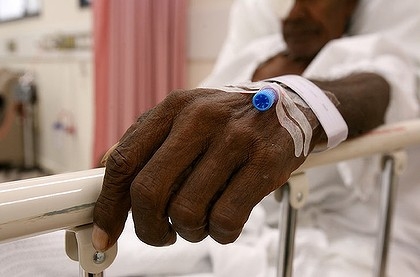
The harsh tragedy at the centre of indigenous health in Australia is anchored to shortened life expectancy and a greater predisposition to chronic illness for Aboriginal and Torres Strait Islander people than the general population.
For indigenous men, life expectancy is 11.5 years less than someone of non-indigenous background. Women are barely 1.5 years better off, with indigenous women having 10 years less than their non-indigenous counterparts.
“The figures can vary,” said Professor Ngiare Brown, executive director of research at the National Aboriginal Community Controlled Health Organisation. “That’s because there are different methods of calculation. But it’s anywhere between 12 and 15 years, and that’s an unacceptable disparity.”
Much of the disparity in life expectancy comes down to chronic disease, much of it preventable, including kidney disease, cardiovascular disease, and a rise in some forms of cancer.
For younger Aboriginal and Torres Strait Islander people, there’s also a high preponderance of self harm, suicide and injuries.
“With adolescents and young people, it’s hard for them to develop a social identity, so the levels of suicide and substance abuse is very high. Dealing with that in a social and medical context is very hard,” Professor Brown said.
So if much of the difference in life expectancy comes down to preventable disease, why isn’t more being done about it? According to Joshua Creamer, a barrister and president of the Indigenous Lawyer’s Association Queensland, who has been active in indigenous health, much of the problem comes down to a lack of access to services.
Access to services
“There are many factors,” he said. “But it generally comes down to access to healthcare and health services. People are living in remote communities, and there simply isn’t the same level of service that there is for people living in larger population centres.”
Professor Brown concurs. “There are real problems associated with access to health services, and the prevention of disease and maintenance of good health,” she said.
There are also intergenerational factors at work, Professor Brown noted. “There is the exposure of parents and grandparents, and this continues down through the generations,” she said.
“Mental health, social and emotional and cultural wellbeing are also issues,” she continued. “There are the usual pressures of family and community education and employment. Layer that with complexities [in terms of] exposure to policies, extermination, identity and cultural responsibility and indigenous health becomes a very hard area to deal with.”
Professor Brown and Mr Creamer were concerned about the effect of the recent budget on Aboriginal and Torres Strait Islander populations.
Professor Brown said a completely free system is becoming unsustainable. “It was meant to be a safety net, but people have become accustomed to completely free care,” she said.
Yet on the other hand, she noted, people who can already afford private care will use it in any case. The impact of introducing co-payments, and increasing the pension age to 70, will be on people and populations that cannot already afford private primary care.
Budget harm
“It’s going to be a mess,” she stated. “The impact will be more on the people who cannot afford it. There needs to be detailed and careful consideration of intended and unintended consequences of fee for services [if the changes] are going to be a success and not hurt people who cannot already afford healthcare.”
In terms of the budget measures, Brown continued, the impact on indigenous people is twofold. “We are the most disadvantaged population in Australia and secondly, we have the highest burden of morbidity and mortality. Our services rely on MBS and medicare rebates to provide affordable services.
“If you reduce Medicare rebate and charge a fee, for people with multiple visits, chronic disease, children with special needs, the families will not be able to afford it.”
On a positive note, Mr Creamer said under the budget funding for Aboriginal Community Controlled Healthcare will continue, and that type of healthcare remains a bright spot when it comes to dealing with the healthcare issues of Aboriginal and Torres Strait Islander people.
Professor Brown said she remains an optimist, despite the harrowing life expectancy and disease statistics. “If it was that bad, I would not continue doing what I do. “I remain an optimist because community health centres are locally led responses to local priorities. In the end, however, what we need is collaboration, between policymakers and government to address indigenous health in a more integrated manner.”
Source: Australian Financial Review
